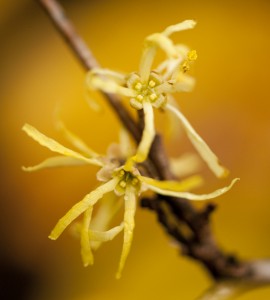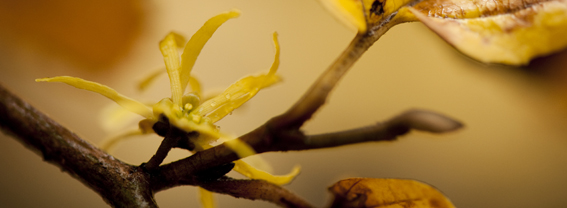Witch-hazels
Posted in Around the Garden on November 6 2012, by Matt Newman
Sonia Uyterhoeven is the NYBG‘s Gardener for Public Education.
 Early one morning in late October, I drove down Daffodil Hill and around to the Azalea Garden. As I was rounding the corner, I found myself arrested by one of my favorite late season fragrances. I can never describe the scent–some call it slightly spicy. All I can tell you is that it is clean, inviting, and has a pleasant perfume that isn’t overpowering. But one thing is certain: fragrance is an unexpected pleasure this late in the season.
Early one morning in late October, I drove down Daffodil Hill and around to the Azalea Garden. As I was rounding the corner, I found myself arrested by one of my favorite late season fragrances. I can never describe the scent–some call it slightly spicy. All I can tell you is that it is clean, inviting, and has a pleasant perfume that isn’t overpowering. But one thing is certain: fragrance is an unexpected pleasure this late in the season.
The plant in question is our native witch-hazel (Hamamelis virginiana), which was given its name because its forked branches were once used as divining rods. These “V” or “Y”-shaped branches were taken up by those who felt them useful in locating underground water–a practice formerly known as “water witching.”
A lovely benefit of anything that flowers in late fall (or winter through early spring) is that the flowers tend to last for a long time. The cool weather slows down senescence and the flowers linger for weeks. On warmer days, the fragrance wafts through the air, advertising to local insects that the flowers are there.
I also love the shape of the flowers–they look like the pale yellow floral equivalent of sea urchins, with petals radiating out in all directions. In contrast to all the brassy blooms that we have in the Garden, the flowers of the witch-hazel are subtle and intriguing, and even though it can be a challenge to catch them while the foliage is up and turning its spectacular yellow fall color, they are interesting enough not to recede into the background. Once the foliage is gone, they stand out like a beacon on a cold, fall day.

In terms of size, witch-hazels can grow to over 20 feet tall. The specimens that we have in the Garden on the corner of Azalea Way and Daffodil Hill are mature specimens that are full size. Young plants, on the other hand, have a nice vase shape. As they grow, they retain their vase-like habit with some branches bending horizontally to create an artistic framework. Witch-hazels grow easily as a forest understory plant, and for the homeowner they are particularly useful as shrubs that prefer partial shade. Their branches fan out in a slightly flattened vase-shape, capturing the sunlight that penetrates the forest canopy.
No matter your preference, there is a witch-hazel available to take you through the entirety of the winter months. The common witch-hazel (Hamamelis virginiana) flowers in late autumn from October into December; the vernal witch-hazel (Hamamelis vernis) flowers in late winter; and the Chinese witch-hazel (Hamamelis mollis) flowers in late winter to early spring.
 These are all garden-worthy plants that will provide winter interest to the homeowner. If they grow too large for their location, they can either be rejuvenated or the older, larger branches can be removed to make space for younger (smaller) ones. For my two cents, I do think it is best if you just give it the space it needs to grow and enjoy its beautiful habit.
These are all garden-worthy plants that will provide winter interest to the homeowner. If they grow too large for their location, they can either be rejuvenated or the older, larger branches can be removed to make space for younger (smaller) ones. For my two cents, I do think it is best if you just give it the space it needs to grow and enjoy its beautiful habit.
Perhaps the biggest selling point of witch-hazel is the time of year in which it flowers. Gardeners are hard-pressed to find flowers in the winter months, and these fragrant plants provide a durable and dependable option. When you add witch-hazel’s elegant, vase-shaped form and coarsely-toothed green foliage–turning a brilliant yellow in the fall–you have yourself a real winner.

